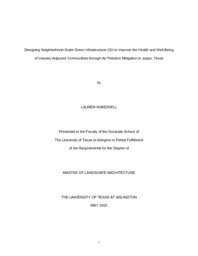| dc.description.abstract | Ambient outdoor air pollution kills roughly 4.2 million people every year worldwide and is linked as a contributing factor to diseases such as asthma, cancer, infertility, and neurological disorders. In the United States, minority communities are more likely to live near sources of air pollution, such as highways and industrial sites, and therefore face higher risks of developing the associated health difficulties. According to the Environmental Protection Agency (EPA), people of color (POC) are exposed to disproportionately higher levels of ambient fine particulate matter (PM) air pollution, regardless of income levels or region. While the EPA monitors and enforces outdoor air quality standards across the US, there are not regulatory standards for the distances between air pollution sources and neighborhoods. There is a need for site-specific and short-term solutions. The EPA recommends tree planting as a strategy for improving air quality, with total annual air pollution removal by US urban trees estimated to be 711,000 metric tons, a $3.8 billion value. This design thesis explores the benefits of Green Infrastructure (GI) in addressing air pollution as well as secondary benefits including but not limited to decreased flood risk, increased access to open green space, and increased-community value. A multi-method approach is used to study the issues of air pollution and vegetation, employing GIS-mapping, case-studies, expert interviews, and i-Tree planting calculator to produce findings which can inform a design. The GIS findings resulted in a map of Dallas revealing where PM air pollution and asthma rates are highest. Case studies revealed how landscape architecture has addressed air pollution in other scenarios and informed the development of design principles: greener edges, green gradient, green lots and green corridors. Expert interviews resulted in recommendations on site specific solutions for addressing air pollution, by sharing maps and data with the interviewees. Lastly, i-Tree planting calculator produced from a list of trees the quantifiable benefits of a planting plan, such as PM captured, Ozone removed, Stormwater intercepted, and Carbon sequestered. Then, the design principles, the planting palette, and other findings of this research are then applied to a master plan design for Joppa, Texas, a low-income Dallas freedmen’s town that is currently exposed to high levels of air pollution and secondary health risks such as flooding, lack of public transit and lack of immediate access to grocery stores. | |


